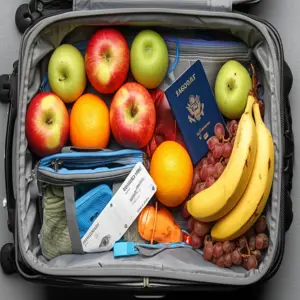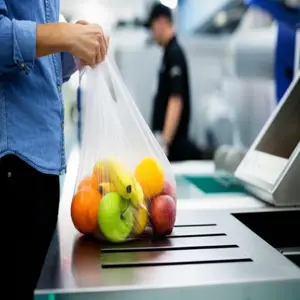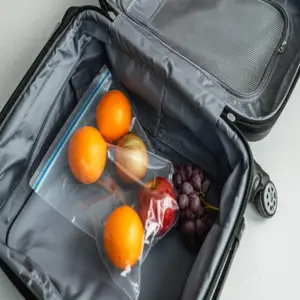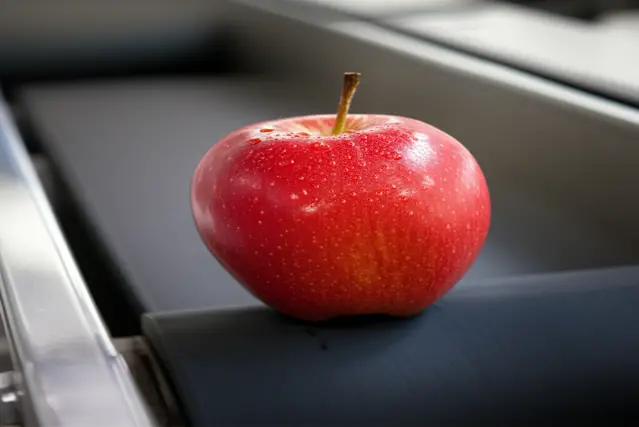Planning a trip and wondering if you can pack your favorite fruits? You’re not alone! Navigating the rules and regulations surrounding food on airplanes can be confusing. This comprehensive guide provides the most up-to-date information for 2025, covering everything from TSA guidelines to international restrictions. Whether you’re craving a juicy apple on your next flight or bringing home exotic fruits from your travels, this guide will help you pack smart and avoid any airport hassles.
In 2025, more travelers than ever are looking for ways to bring their own food on flights, both to save money and to ensure they have access to healthy options. But with increasing security measures and varying international regulations, it’s crucial to stay informed. Let’s dive into the world of fruit and air travel!
Table of Contents
Understanding the Basics: TSA and Fruit
The Transportation Security Administration (TSA) plays a crucial role in airport security, and their regulations often dictate what you can and cannot bring on a plane. When it comes to fruit, the good news is that most fresh fruits are generally allowed in both carry-on and checked baggage within the United States.
TSA Guidelines on Fresh Fruit
According to the TSA, fresh fruits are permissible through security checkpoints. However, there are a few key considerations:
- Solid vs. Liquid: Whole, fresh fruits are considered solid food items and are typically allowed without restrictions. However, fruit that has been processed into a liquid (e.g., juice, smoothie) is subject to the TSA’s 3-1-1 rule for liquids in carry-on baggage.
- Inspection: TSA officers have the discretion to inspect any item, including fruit. If an officer has concerns, they may ask you to open your bag for inspection.
- Quantity: There are generally no quantity restrictions on fresh fruit for domestic flights. However, it’s always a good idea to pack responsibly and consider the weight and space limitations of your baggage.
For instance, bringing a whole apple or a bunch of grapes is usually fine. However, a large container of fruit salad might raise eyebrows due to its potential liquid content. It is always best to err on the side of caution and pack such items in your checked luggage, or consume before going through security.

airport fruit restrictions
Specific Examples of Fruits and TSA Rules
Here’s a quick rundown of how some common fruits fare under TSA regulations:
- Apples, Bananas, Oranges: Generally allowed in both carry-on and checked baggage.
- Berries (Strawberries, Blueberries, Raspberries): Allowed, but consider packing them in a container to prevent crushing.
- Melons (Watermelon, Cantaloupe): Whole melons are typically allowed. Cut melons might be subject to closer inspection due to moisture.
- Grapes: Allowed in both carry-on and checked baggage.
- Pineapple: Whole pineapples are generally allowed. Cut pineapple might be subject to closer inspection.
It is always advisable to check the latest TSA guidelines on their website or app before your travel date. Regulations can change, and it’s better to be safe than sorry.
What About Dried Fruit and Nuts?
Dried fruits and nuts are also generally allowed in both carry-on and checked baggage. These make great travel snacks because they are lightweight, non-perishable, and easy to pack. TSA treats them as solid food items and do not have any specific restrictions on the quantity you carry.
However, large quantities of nuts may sometimes raise concerns during security screening, as they can obscure other items in your bag. If you’re carrying a significant amount, it might be helpful to separate them for easier inspection.
Read More: About Can You Bring Cigars on a Plane? Travel Guide
Navigating International Travel with Fruit
While the TSA primarily focuses on security threats, international travel introduces another layer of complexity: agricultural regulations. Many countries have strict rules about bringing fruits and other agricultural products across their borders to prevent the spread of pests and diseases.
Understanding Agricultural Restrictions
The primary reason for these restrictions is to protect local agriculture. Introducing foreign pests or diseases can devastate crops and ecosystems. Therefore, customs officials often inspect baggage for agricultural items and may confiscate prohibited fruits.
Before traveling internationally with fruit, it’s crucial to research the specific regulations of your destination country. Here are some resources:
- USDA APHIS (Animal and Plant Health Inspection Service): Provides information on U.S. import and export regulations.
- Destination Country’s Customs Website: Most countries have official websites outlining their customs regulations.
- Embassy or Consulate: Contacting the embassy or consulate of your destination country can provide specific guidance.
Failure to comply with these regulations can result in fines, confiscation of the fruit, or even more serious penalties.
Common International Restrictions
Here are some common patterns in international fruit restrictions:
- Fresh Fruits and Vegetables: Often prohibited or restricted, especially if coming from regions with known agricultural pests or diseases.
- Citrus Fruits: Frequently subject to restrictions due to the risk of citrus diseases.
- Fruits with Soil: Fruits with soil attached are generally prohibited.
- Seeds and Plants: Often restricted to prevent the introduction of invasive species.
For example, Australia has very strict quarantine laws. Bringing fresh fruit into Australia without proper declaration and inspection can lead to hefty fines.
Examples of Country-Specific Regulations
Let’s look at a few examples of country-specific regulations regarding fruit:
| Country | Fruit Restrictions | Notes |
|---|---|---|
| United States | Generally allows most fruits for domestic travel; restrictions apply for entry into Hawaii and Puerto Rico from the mainland due to local agricultural concerns. | Check USDA APHIS for specific restrictions. |
| Canada | Restrictions vary depending on the origin of the fruit. Some fruits may require import permits. | Consult the Canadian Food Inspection Agency (CFIA) website. |
| Australia | Very strict quarantine laws. Most fresh fruits are prohibited unless declared and inspected. | Declare all food items upon arrival. |
| European Union | Restrictions vary depending on the origin and type of fruit. Import permits may be required. | Check the European Commission website for specific regulations. |
| Japan | Strict regulations on importing fresh fruits and vegetables. Import permits are often required. | Contact the Plant Protection Station of Japan for details. |
Before traveling, always verify the latest regulations with the relevant authorities. Regulations can change quickly, and relying on outdated information can lead to problems.
The Case of Hawaii and Puerto Rico
Even within the United States, there are restrictions on bringing fruits into Hawaii and Puerto Rico from the mainland. These islands have unique ecosystems that are vulnerable to invasive species and diseases.
For example, you cannot bring many types of fresh fruits and vegetables into Hawaii from the mainland. These restrictions are enforced by the Hawaii Department of Agriculture. Similarly, Puerto Rico has its own agricultural regulations to protect its local crops.
If you’re traveling to Hawaii or Puerto Rico, check the local agricultural regulations before packing any fruits or vegetables. You can usually find this information on the state or territory’s Department of Agriculture website.
Packing Fruit for Air Travel: Best Practices
Even if your fruit is allowed on the plane, packing it properly is essential to prevent damage, spoilage, and potential messes. Here are some best practices for packing fruit for air travel:
Choosing the Right Container
The type of container you use depends on the type of fruit and how much you’re bringing:
- Hard-skinned fruits (apples, oranges): Can be packed in a durable container or wrapped individually in plastic wrap or reusable food wraps.
- Soft fruits (berries, grapes): Should be packed in a hard-sided container to prevent crushing.
- Cut fruits (melon, pineapple): Pack in an airtight container to prevent leakage and spoilage. Consider using a container with a tight seal to minimize odors.
- Dried fruits and nuts: Can be packed in resealable bags or containers.
Reusable containers are a great option for packing fruit. They are durable, easy to clean, and environmentally friendly. Look for containers that are leak-proof and BPA-free.
Preventing Bruising and Damage
To prevent bruising and damage during transit, consider these tips:
- Wrap individual fruits: Use plastic wrap, reusable food wraps, or even paper towels to cushion each fruit.
- Layer soft fruits: Place a layer of padding (e.g., paper towels, cloth) between layers of soft fruits like berries.
- Pack tightly: Fill any empty space in the container with padding to prevent the fruits from shifting.
- Avoid overpacking: Overpacking can lead to crushing and damage.
For delicate fruits like peaches or plums, consider wrapping them in bubble wrap for extra protection.
Keeping Fruit Fresh During Travel
To keep your fruit fresh during your trip, consider these strategies:
- Choose fresh fruit: Select fruits that are firm and ripe but not overripe.
- Keep it cool: If possible, store your fruit in a cooler or insulated bag with a small ice pack. However, be mindful of the TSA’s liquid restrictions if using ice packs.
- Avoid direct sunlight: Store your fruit in a cool, dark place to prevent it from ripening too quickly.
- Consume promptly: Eat your fruit as soon as possible after arriving at your destination.
If you’re traveling for an extended period, consider bringing dried fruits or nuts instead of fresh fruit, as they are less likely to spoil.
Packing for Carry-On vs. Checked Baggage
Whether you pack your fruit in your carry-on or checked baggage depends on your preferences and the type of fruit:
- Carry-on: Allows you to have easy access to your fruit during the flight. However, you’ll need to comply with the TSA’s liquid restrictions if you have cut fruit or fruit salad.
- Checked baggage: Provides more space and may be a better option for larger quantities of fruit. However, your fruit may be subject to rough handling and temperature fluctuations.
If you’re carrying delicate fruits, it’s generally better to pack them in your carry-on to prevent damage. If you’re bringing a large quantity of fruit, checked baggage may be more practical.
Alternatives to Bringing Fresh Fruit
If you’re concerned about the hassle of packing and transporting fresh fruit, there are several alternatives to consider:
Buying Fruit at the Airport or Destination
One option is to simply buy fruit at the airport or at your destination. Most airports have shops that sell fresh fruit, and you can often find a wider variety of fruits at local markets and grocery stores.
This can be a convenient option, especially if you’re traveling internationally and want to avoid potential customs issues. However, keep in mind that prices at airports can be higher than at local stores.
Dried Fruit, Fruit Snacks, and Fruit Leather
Dried fruit, fruit snacks, and fruit leather are lightweight, non-perishable alternatives to fresh fruit. They are easy to pack and can provide a good source of nutrients and energy during your trip.
However, be mindful of the sugar content of some fruit snacks and fruit leather products. Look for options that are made with natural ingredients and have no added sugar.
Fruit Purees and Pouches
Fruit purees and pouches are another convenient option for traveling with fruit. They are easy to pack and can be a good choice for babies and young children. However, they are subject to the TSA’s 3-1-1 rule for liquids in carry-on baggage.
If you’re bringing fruit purees or pouches in your carry-on, make sure they are in containers that are 3.4 ounces (100 milliliters) or less and that they fit in a quart-sized, clear plastic bag.
Freeze-Dried Fruit
Freeze-dried fruit is an excellent alternative. It is lightweight, shelf-stable, and retains much of the original fruit’s nutrients. It’s also less likely to be subject to agricultural restrictions compared to fresh fruit, as the drying process eliminates most concerns about pests and diseases. Freeze-dried fruit can be a convenient and healthy snack to bring on your travels.
Real-World Examples and Scenarios
Let’s look at some real-world examples and scenarios to illustrate how these rules apply in practice:
Scenario 1: A Family Vacation to Disney World
A family is flying from New York to Orlando for a vacation to Disney World. They want to bring some snacks for the kids, including apples, bananas, and grapes.
In this scenario, the family can bring the apples, bananas, and grapes in their carry-on or checked baggage without any issues. These fruits are allowed under TSA regulations for domestic flights. They should pack the fruits in containers to prevent bruising and damage.
Scenario 2: A Business Trip to Europe
A business traveler is flying from Chicago to Paris for a conference. He wants to bring a bag of his favorite apples with him.
In this scenario, the traveler needs to be aware of the European Union’s agricultural regulations. Bringing fresh apples into the EU may be subject to restrictions or require import permits. It’s best to check the European Commission website or contact the embassy of the specific country he’s visiting to verify the regulations. Alternatively, he could purchase apples in Paris to avoid any potential issues.
Scenario 3: A Cruise to the Caribbean
A couple is embarking on a cruise to the Caribbean from Miami. They want to bring some fresh mangoes from Florida with them to enjoy on the ship.
In this scenario, the couple should check the cruise line’s policies on bringing food onboard. Some cruise lines have restrictions on bringing outside food and beverages. They should also be aware of the agricultural regulations of the Caribbean islands they’ll be visiting, as bringing mangoes ashore may be prohibited.
Scenario 4: A Backpacking Trip Through Southeast Asia
A backpacker is planning a multi-country trip through Southeast Asia. They want to bring a supply of dried fruit and nuts for snacks.
In this scenario, the backpacker can generally bring dried fruit and nuts without major concerns, as these are less likely to be subject to strict agricultural regulations compared to fresh fruit. However, it’s always wise to check the specific rules of each country they’ll be visiting, particularly regarding the import of plant-based products. Additionally, they should ensure that the packaging is airtight to prevent spoilage in the humid climate.
Staying Up-to-Date with Regulations
Regulations regarding food on airplanes can change, so it’s essential to stay up-to-date with the latest information. Here are some tips for doing so:
- Check the TSA website: The TSA website provides the most current information on what you can and cannot bring on a plane in the United States.
- Consult the USDA APHIS website: The USDA APHIS website provides information on U.S. import and export regulations for agricultural products.
- Visit the destination country’s customs website: Most countries have official websites outlining their customs regulations.
- Contact the embassy or consulate: Contacting the embassy or consulate of your destination country can provide specific guidance.
- Use the “Ask TSA” service on Twitter: You can tweet a question to @AskTSA and get a response from a TSA representative.
Remember to check these resources close to your travel date, as regulations can change quickly.
Statistics and Trends in Air Travel and Food
Here are some recent statistics and trends related to air travel and food:
- Increased demand for bringing food on flights: A recent survey found that 70% of travelers prefer to bring their own food on flights to save money and ensure they have healthy options.
- Rise in food allergies: The number of people with food allergies has been increasing, leading more travelers to bring their own food to avoid potential allergens on the plane.
- Growing awareness of food waste: Travelers are becoming more conscious of food waste and are looking for ways to reduce it, such as bringing reusable containers for food.
- Changes in TSA regulations: The TSA has been making some changes to its regulations regarding food, such as allowing larger quantities of breast milk and baby food in carry-on baggage.
These trends highlight the importance of staying informed about the latest regulations and best practices for traveling with food.
The Environmental Impact of Bringing Your Own Food
Bringing your own food on a plane can also have a positive impact on the environment. By packing reusable containers and avoiding single-use plastic packaging, you can reduce waste and minimize your carbon footprint. Here are some ways to make your travel more eco-friendly:
- Use reusable containers: Instead of disposable plastic bags or containers, opt for reusable containers made from materials like stainless steel, glass, or BPA-free plastic.
- Bring your own utensils: Pack a set of reusable utensils made from bamboo or stainless steel to avoid using disposable plastic cutlery.
- Refillable water bottle: Stay hydrated by bringing a refillable water bottle and filling it up after passing through security.
- Avoid individually wrapped snacks: Buy snacks in bulk and portion them out into reusable containers to reduce packaging waste.
- Compostable or biodegradable packaging: If you must use disposable packaging, choose compostable or biodegradable options made from plant-based materials.
By making small changes to your travel habits, you can significantly reduce your environmental impact and contribute to a more sustainable future.
Health and Wellness Considerations
Bringing your own fruit and snacks on a plane can also have health and wellness benefits. It allows you to control what you eat and avoid unhealthy options that may be available on the flight. Here are some tips for making healthy choices:
- Choose whole fruits and vegetables: Whole fruits and vegetables are packed with vitamins, minerals, and fiber, and they are a great source of energy during your travels.
- Avoid processed snacks: Processed snacks are often high in sugar, salt, and unhealthy fats. Opt for whole foods instead.
- Stay hydrated: Drink plenty of water during your flight to stay hydrated and prevent dehydration.
- Pack a variety of foods: Pack a variety of fruits, vegetables, nuts, and seeds to ensure you’re getting a balanced diet.
- Consider your dietary needs: If you have any dietary restrictions or allergies, be sure to pack foods that meet your needs.
By planning ahead and packing healthy snacks, you can stay energized and feel your best during your travels.
Tips for Traveling with Fruit for Babies and Children
Traveling with babies and children can be challenging, but bringing your own fruit and snacks can make the journey easier. Here are some tips for traveling with fruit for babies and children:
- Pack soft fruits: Soft fruits like bananas, avocados, and peaches are easy for babies and young children to eat.
- Cut fruits into small pieces: Cut fruits into small, bite-sized pieces to prevent choking hazards.
- Bring fruit purees or pouches: Fruit purees and pouches are a convenient option for feeding babies and young children on the go.
- Avoid sugary snacks: Avoid sugary snacks like candy and cookies, as they can lead to sugar crashes and hyperactivity.
- Pack extra: Always pack extra food in case of delays or unexpected circumstances.
By packing healthy and convenient snacks, you can keep your babies and children happy and well-fed during your travels.
Read More: Can You Bring a PS5 on a Plane? Rules & Travel Tips 2025
The Future of Food on Airplanes
The future of food on airplanes is likely to be shaped by several factors, including changing consumer preferences, technological advancements, and environmental concerns. Here are some potential trends:

travel snacks allowed
- More healthy and sustainable food options: Airlines may offer more healthy and sustainable food options to cater to growing consumer demand.
- Personalized meal options: Airlines may use technology to offer personalized meal options based on passengers’ dietary needs and preferences.
- Pre-ordering food online: Passengers may be able to pre-order food online before their flight and have it delivered to their seat.
- In-flight food delivery: Airlines may partner with food delivery services to offer in-flight food delivery options.
- Reduced food waste: Airlines may implement strategies to reduce food waste, such as offering smaller portion sizes and donating leftover food to charities.
These trends suggest that the future of food on airplanes will be more convenient, healthy, and sustainable.
DIY Fruit Snacks for Travel
Want to avoid processed snacks altogether? Consider making your own fruit snacks at home before your trip. This way, you have complete control over the ingredients and can ensure they are healthy and delicious. Here are a couple of simple DIY fruit snack ideas:
Homemade Fruit Leather
Fruit leather is a great way to preserve fruit and create a chewy, portable snack. Simply blend your favorite fruits (berries, mango, applesauce) and spread the puree thinly on a baking sheet lined with parchment paper. Bake at a very low temperature (around 170°F) for several hours until the puree is dry and leathery. Cut into strips and store in an airtight container.
Baked Apple Chips
For a crispy and satisfying snack, try making baked apple chips. Thinly slice apples (a mandoline slicer works well) and toss them with a sprinkle of cinnamon. Arrange the slices on a baking sheet and bake at a low temperature (around 200°F) for about 2-3 hours, flipping halfway through, until they are crispy. Store in an airtight container to maintain their crunch.
Dealing with Fruit Confiscation
Despite your best efforts to comply with regulations, there’s always a chance that your fruit could be confiscated by customs or security officials. Here are some tips for handling this situation:
- Stay calm and respectful: Arguing or becoming aggressive will likely make the situation worse. Remain polite and cooperative.
- Ask for clarification: If you’re unsure why your fruit is being confiscated, ask for a clear explanation of the regulations.
- Request documentation: If possible, ask for written documentation of the confiscation, including the reason and the name of the official.
- Accept the decision: Ultimately, the decision of the customs or security official is final. Accept the confiscation and move on.
- Learn from the experience: Use the experience as a learning opportunity and research the regulations more thoroughly before your next trip.
Remember, it’s always better to be safe than sorry. If you’re unsure about whether a particular fruit is allowed, it’s best to leave it at home.
Fruit-Infused Water for the Flight
Staying hydrated on a flight is crucial, and fruit-infused water is a refreshing and healthy way to do it. Simply add slices of your favorite fruits (cucumber, lemon, berries) to a water bottle and let it steep for a few hours. This adds flavor and vitamins to your water, making it more enjoyable to drink. Remember that if you’re bringing an empty water bottle through security, you can fill it up at a water fountain afterwards.
Luxury Travel and Exotic Fruits
For luxury travelers, bringing exotic fruits on a plane might be part of enhancing their travel experience. However, the same rules apply, and even expensive or rare fruits are subject to agricultural regulations. It’s crucial to be particularly cautious with exotic fruits, as they may be more likely to harbor pests or diseases that could be harmful to local agriculture. Researching the regulations of your destination country and obtaining any necessary permits or documentation is essential.
Creative Fruit Presentation Ideas for Travel
If you’re looking to add a touch of creativity to your travel snacks, consider these fruit presentation ideas:
- Fruit skewers: Thread bite-sized pieces of fruit onto skewers for a fun and easy-to-eat snack.
- Fruit salad in a jar: Layer different types of fruit in a jar for a visually appealing and portable snack.
- Fruit and cheese pairings: Combine fruit with cheese for a sophisticated and satisfying snack.
- Fruit parfaits: Layer fruit with yogurt and granola in a clear container for a healthy and delicious treat.
These creative presentations can make your travel snacks more enjoyable and memorable.
Beyond Fruit: Other Food Items to Consider
While we’ve focused primarily on fruit, it’s worth considering other food items you might want to bring on a plane. Here’s a brief overview of some common options:
- Snacks (nuts, seeds, granola bars): Generally allowed in both carry-on and checked baggage.
- Sandwiches and wraps: Allowed, but consider packing them in a container to prevent crushing.
- Cheese and crackers: Allowed, but soft cheeses might be subject to the TSA’s liquid restrictions.
- Cooked meals: Allowed, but consider packing them in airtight containers to prevent leakage and odors.
- Liquids (soups, sauces): Subject to the TSA’s 3-1-1 rule for liquids in carry-on baggage.
As with fruit, it’s always best to check the latest TSA guidelines and the regulations of your destination country before traveling with food.
Ethical Considerations: Supporting Local Farmers
When considering whether to bring fruit on a plane, it’s also worth thinking about the ethical implications. Supporting local farmers and economies at your destination can be a positive way to contribute to the community. Instead of bringing fruit from home, consider purchasing it from local markets or farms at your destination. This can help support local businesses and reduce the environmental impact of transporting food over long distances.
The Role of Technology in Food Travel
Technology is playing an increasingly important role in making food travel easier and more convenient. Apps like the TSA app and websites like the USDA APHIS website provide up-to-date information on regulations and restrictions. Online forums and travel communities can offer valuable insights and tips from other travelers. And online ordering and delivery services can make it easier to purchase food at your destination.
Travel Trends: Healthy Eating on the Go
A growing trend in travel is the emphasis on healthy eating while on the go. Many travelers are prioritizing their health and wellness and are looking for ways to maintain a healthy diet while traveling. This has led to an increased demand for healthy food options at airports and on planes, as well as a greater interest in bringing your own healthy snacks and meals.
Cultural Considerations: Food as a Gift
In some cultures, food is a common and cherished gift. If you’re planning to bring fruit as a gift to someone at your destination, it’s especially important to be aware of the agricultural regulations. You don’t want to inadvertently cause problems for the recipient by bringing a prohibited item. Consider alternative gifts that are not subject to the same restrictions, such as locally made crafts or souvenirs.
Fruit and Travel Photography
For many travelers, documenting their experiences through photography is an important part of the journey. Fruit can be a colorful and visually appealing subject for travel photos. Whether you’re capturing the vibrant colors of a local market or creating a still life with exotic fruits, incorporating fruit into your travel photography can add a unique and memorable element.
Sustainable Travel: Choosing Local and Seasonal Fruits
If you’re committed to sustainable travel, consider choosing local and seasonal fruits whenever possible. This reduces the environmental impact of transporting food over long distances and supports local farmers and economies. When you arrive at your destination, ask about the fruits that are in season and try to sample the local varieties. This can be a delicious and eco-friendly way to experience the local culture.
The Psychology of Food and Travel
Food plays a significant role in our travel experiences, often evoking memories and emotions. The aroma of a particular fruit or dish can transport us back to a specific place or time. Bringing familiar fruits on a plane can provide a sense of comfort and familiarity, especially when traveling to unfamiliar destinations. It can also be a way to maintain a sense of routine and normalcy during travel.
Last-Minute Fruit Packing Tips
Running late for your flight? Here are some quick last-minute fruit packing tips:
- Grab a banana: A banana is a quick and easy snack that requires no preparation.
- Wash and go: Wash your fruit thoroughly before packing it.
- Use a plastic bag: If you don’t have a reusable container, a plastic bag will suffice for short trips.
- Keep it cool: Store your fruit in a cool place until you’re ready to leave.
Common Mistakes to Avoid
Here are some common mistakes to avoid when traveling with fruit:

fresh produce carry-on
- Not checking regulations: Always check the latest TSA guidelines and the regulations of your destination country.
- Packing prohibited items: Avoid packing fruits that are known to be prohibited.
- Failing to declare items: Declare all food items to customs officials, even if you’re not sure if they’re allowed.
- Packing improperly: Pack your fruit properly to prevent damage and spoilage.
- Arguing with officials: Stay calm and respectful when dealing with customs or security officials.
Resources for Further Information
Here are some useful resources for further information on traveling with food:
- TSA Website: https://www.tsa.gov/
- USDA APHIS Website: https://www.aphis.usda.gov/
- Destination Country’s Customs Website: Search online for the official customs website of your destination country.
- Embassy or Consulate Website: Search online for the website of the embassy or consulate of your destination country.
FAQ: Your Burning Questions Answered
Can I bring an apple in my carry-on baggage?
Yes, apples are generally allowed in both carry-on and checked baggage on domestic flights. Make sure it’s whole and not sliced into a fruit salad with a lot of liquid.
Are there any fruits I can’t bring into the United States from another country?
Yes, many fresh fruits are restricted due to agricultural regulations. It’s best to check the USDA APHIS website for a list of prohibited items before traveling.
What about bringing fruit snacks or dried fruit?
Fruit snacks and dried fruit are generally allowed in both carry-on and checked baggage without any restrictions.
Can I bring a smoothie or fruit juice in my carry-on?
Smoothies and fruit juice are subject to the TSA’s 3-1-1 rule for liquids. They must be in containers that are 3.4 ounces (100 milliliters) or less and fit in a quart-sized, clear plastic bag.
What happens if I accidentally bring a prohibited fruit into a country?
Customs officials may confiscate the fruit, and you could face fines or other penalties. It’s best to declare all food items and allow the officials to inspect them.
Are there any exceptions for medical reasons or dietary restrictions?
The TSA may make exceptions for medically necessary foods, but you may need to provide documentation from your doctor. It’s best to contact the TSA or your airline in advance to inquire about specific situations.
Can I bring fruit into Hawaii or Puerto Rico from the mainland U.S.?
There are restrictions on bringing many types of fresh fruits and vegetables into Hawaii and Puerto Rico from the mainland due to local agricultural concerns. Check the Hawaii Department of Agriculture or the Puerto Rico Department of Agriculture for specific regulations.
How do I pack fruit to prevent it from getting bruised?
To prevent bruising, pack soft fruits like peaches or berries in a hard-sided container with padding (like paper towels or bubble wrap) between layers. Wrap individual fruits like apples or pears in cloth or beeswax wraps to cushion them, and avoid overpacking to reduce pressure. For extra protection, place delicate fruits in separate compartments (like an egg carton) and keep them cool with an insulated bag if traveling for long periods.
Final Words
Traveling with fruit can be a convenient and healthy way to enjoy your favorite snacks while on the go, but it’s essential to stay informed about TSA guidelines and international agricultural restrictions. Whether you’re packing fresh, dried, or freeze-dried fruit, proper preparation and research will help you avoid hassles at security or customs. By following best practices—such as choosing sturdy containers, checking destination-specific rules, and considering eco-friendly alternatives—you can ensure a smooth and enjoyable travel experience.
Remember, when in doubt, opt for locally purchased fruit at your destination to support sustainable practices and immerse yourself in the local flavors. Safe travels, and happy snacking!
Final Tip: Bookmark the TSA and USDA APHIS websites for quick reference before your next trip, and always declare food items when entering a new country to avoid penalties. Bon voyage!






